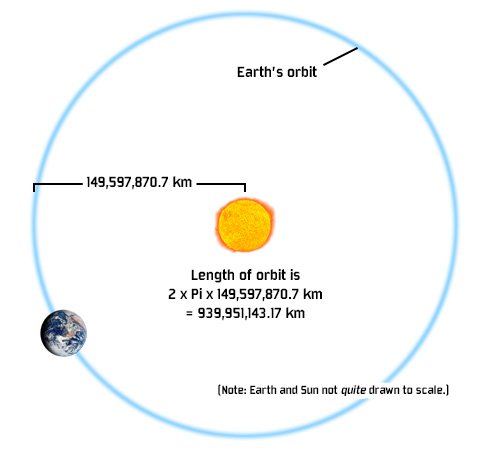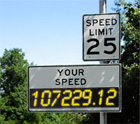
The average distance between the Earth and the sun is about 149,597,870.7 kilometres, otherwise known as one Astronomical Unit, or "AU".
The Earth's orbit around the sun is not perfectly circular, but it's very close, so let's say that it's circular because that makes our calculations a lot simpler.* To find the length of the circumference of a circle, we use the formula 2 x Pi x r, where r is the radius. In this case, the radius is one AU...

So, the Earth travels about 939,951,143.17 kilometres every year, and a year is 365.2425 days long (the bits after the decimal point are why we get an extra day during leap-years - trust me, it all works out!)...
939,951,143.17 ÷ 365.2425 = 2,573,498.82
 Our planet (and everything on it) is travelling around the sun at a speed of over two and a half million kilometres per
day.
Our planet (and everything on it) is travelling around the sun at a speed of over two and a half million kilometres per
day.
Or, if you prefer, about 107,229.12 kilometres per hour.
(For those who are unfamiliar or uncomfortable with the metric system, that comes to 66,629.08 miles per hour.)
Now, in case you've ever wondered just how far the Earth has taken you since you were born, just enter your birth date - and time, if you know it - below. Note that the time should be entered in 24-hour format.
(Of course, the sun is also travelling around our galaxy, and the galaxy itself is moving, and the universe is expanding, but those calculations are outside the scope of this utility, plus I don't know the figures, so we'll set all that to one side for now...)
Update: I've added the "Light-years travelled" feature, which brings about an interesting observation on the scale of the universe... The Earth's yearly journey around the sun of 939,951,143.17 km is about one ten-thousandth of a light-year (which is the distance an object can travel in a year when moving at the speed of light). The closest star to our own sun is Proxima Centauri, 4.24 light-years away.
This means that even at the seemingly impressive speed at which we're orbitting the sun, it would take us 42,676 years to reach Proxima Centauri, by which time we'd probably have forgotten why we were going there in the first place.
Further update: When it comes to very large or very small numbers JavaScript (the programming language in which this is written) can get confused a little and start to give best-guess approximations. The upshot of this is that the calculation of light years is a little dodgy when the answer is smaller than 0.0000001. (So please don't hold me responsible if you've been relying on my calculations and find that your space-ship suddenly veers off-course and gets eaten by the giant space-dragons that lie in wait beyond the edge of the universe.)
* A pedant writes: "A pedant might point out that the orbit is elliptical and that the speed varies, being greatest when Earth is closest to the Sun in early January." The pedant is correct: the difference between the orbit's aphelion (closest to the sun) and its perihelion (farthest from the sun) is about 5 million kilometres, so it has a ratio of about 1.034 - close enough to a circle for our purposes!
If you like this software and find it useful, don't worry - you don't have to pay me anything! But if you're feeling generous then please buy one of my books to demonstrate your gratitude.